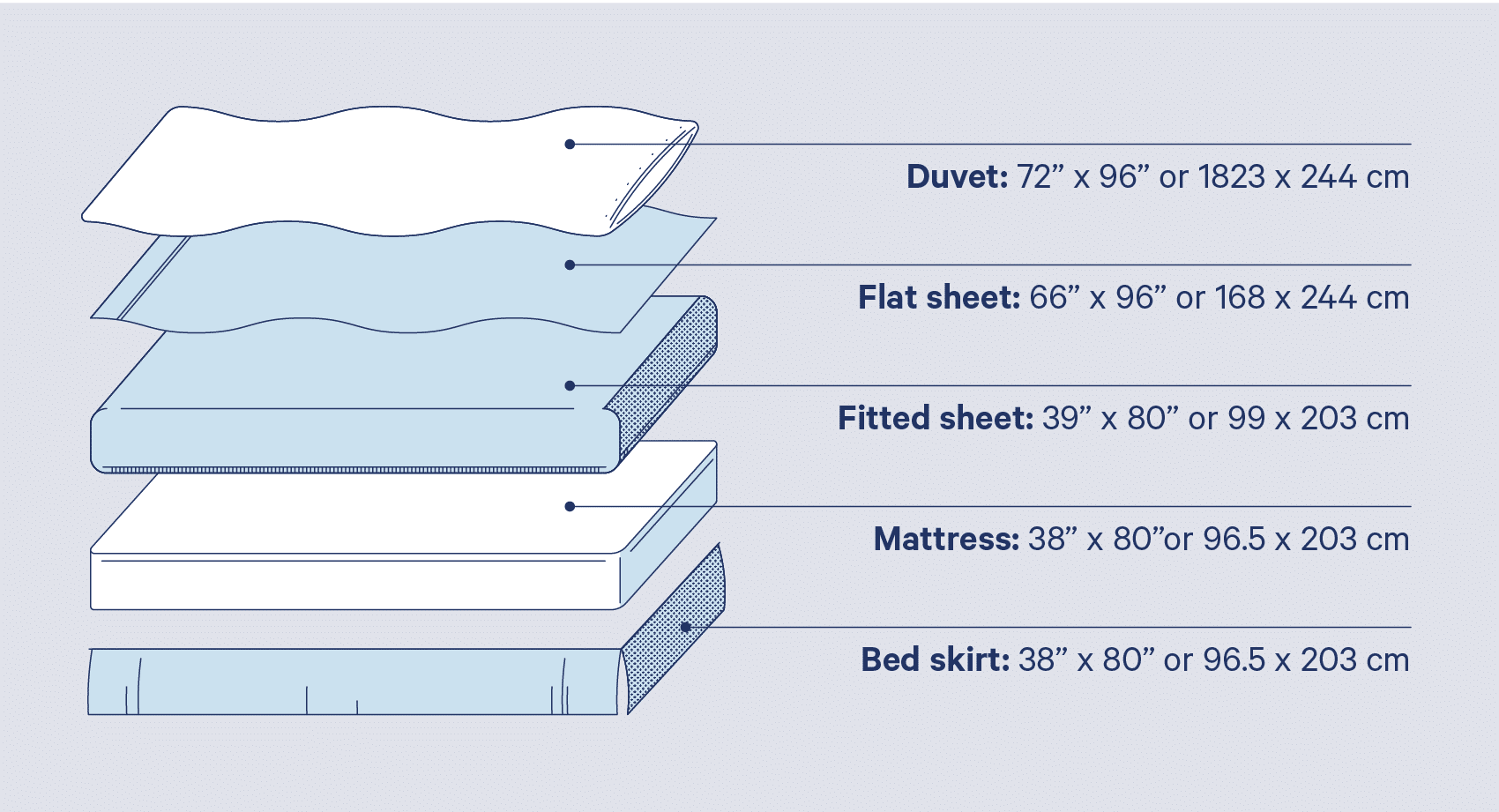Are you wondering how to choose the best sheet from the different types of bed sheets available? You are at the right place.
Good bedsheets can make the bed comfy. They are also colorful; choosing the right one can spice up your room décor.
But how can you know that you are buying the best for you? No one loves the journey of going back and forth to return purchased bed sheets.
This post will reveal the different types of bed sheets, weaves, and their features.
Different Types of Bed Sheets for Every Home

1. Cotton
As the most popular fabric in bedsheet production, cotton is preferred by many, including its durability, breathability, ease of care, softness, and general affordability.
However, there are different types of cotton. While some refer to the original cotton fibers, others describe the methods of fabric treatment.
The following are the most different types of bed sheets made from cotton:
2. Egyptian Cotton
This kind of cotton has incredible durability and a smooth finish. It is also of the highest quality and resistant to pilling.
It is produced from the longest available cotton fibers and made with extra-long staples. Due to all the great features, this kind of cotton bed sheet can be pretty pricey.
3. Pima Cotton
The closest to Egyptian cotton is the Pima cotton. It is also made with long staples, high quality, and good durability. Pima bedsheets also provide luxurious softness without the high price tag of Egyptian cotton.
4. Upland Cotton
The upland cotton is of lower quality than the Egyptian and Pima cotton. It is made from short-staple cotton, and its labels read 100% cotton. They are not as soft as the other types of cotton but are pretty durable.
5. Flannel cotton
The flannel bed sheet material is made from cotton fibers combed to fluff up. They are mainly used for a cold winter night as they are very soft and help trap body heat. The plain or twill weaves of flannel sheets make them soft and pliant.
6. Jersey cotton
This type of cotton bed sheet is similar to the stretchy T-shirts we use. They are soft and easy to clean, but due to their pliable nature, they pill with age and are not very luxurious. Also, they are not very durable like other cotton sheets and tend to stretch out with time.
7. Polyester
These are synthetic fibers produced from polymers, the same that are used for making plastic bottles for drinks. The polyester material is not expensive and rough when used alone.
However, when used for sheets, you’ll quickly find them mixed with other materials. Polyester sheets are available in the following forms:
8. Microfiber
Microfiber fabric is a form of finely woven polyester. Though it is not as breathable as cotton, the fine weaves make it very soft.
However, it is not a very stable choice for hot sleepers. Since they are stain-resistant and durable, they are great for a child’s bedroom.
9. Acrylic
Acrylic is a synthetic material that’s less comfortable on the skin than natural fibers. It is wrinkle-resistant and used to make very colorful bedding. Acrylic is best used to produce comforters and blankets but must be carefully washed to avoid pilling.
10. Nylon
Nylon is a synthetic material known for its durability and strength. It is used to make satiny and soft bed sheets that are wrinkle-resistant.
After a few washings, nylon may pill up and is not suitable for high-heat dryers or clothes irons. Sometimes, high sunlight can also be problematic for nylons.
11. Bamboo
Though bamboo fibers can be processed into fabrics, they are usually rough and stiff. So, those bedsheets labeled bamboo are usually rayon.
This means that the pulps from bamboo were chemically processed, dissolved, re-solidified, and spun into threads.
This process is not helpful to Mother Earth, so bamboo sheets are not as environmentally friendly as the manufacturers claim.
However, they can be durable, soft, and silky like other fabrics. Also, like cotton, they are breathable and have a good feel on the skin.
12. Silk
Silk fibers are produced from the silkworm. They require a delicate production process, which makes them very expensive. Silk feels good on the skin, is naturally hypoallergenic, and is very luxurious. Nevertheless, it is very laborious to maintain.
13. Linen
Linen sheets are very airy and suitable for hot sleepers and people with allergies, as they are generally hypoallergenic.
They are an ideal material for making bedsheets, but they can sometimes be stiff. Also, it tends to fade off when washed and can never be as soft as cotton.
14. Tencel
Tencel is the brand name for lyocell, a fiber made from wood pulp, especially eucalyptus.
The material is environmentally friendly and resistant to wrinkles. It is made from a closed-loop process, and all the wastes generated from its production are reusable.
Though they are not as breathable as linen or cotton, they suit eco-conscious customers.
15. Satin
Satin is a synthetic fiber with an alluring feel. Their bedsheets are either woven or knitted, but the woven materials are smoother than the knitted ones.
Different Types of Bed Sheet Sizes

Bed sheets are of different sizes. Listed below are the most used bed sheet sizes that you should know.
1. Twin
The twin bed sheets are 39 inches X 75 inches and are mainly used for twin-sized beds in children’s rooms. The twin XL sheets give this bed enough to help people be comfortable at night. They also have enough length to ease the bed-making process.
2. Double
The double-size bed sheet is between a twin bed but usually smaller than a queen-sized bed. Though they are mostly called “double,” some manufacturers call them “full.”
It measures 54 inches X 75 inches and provides enough room for three people to sleep in the bed.
The flat double bed has different types of bed sheets in different sizes, so you should choose the one that is most suitable for your mattress.
3. Queen
The queen-size bed sheet measures 59 inches X 79 inches. Like the double beds, queen-size beds come in various sizes, so you should choose the one that suits your mattress.
They are available in loose and fitted sheets, but if you buy the wrong size, it can be frustrating to sleep on.
4. King
The king-size bed sheet measures 80 inches X 80 inches. It is a very large sheet that suits the king-sized bed, and because of its size, it is more expensive than the queen-sized bed sheets.
It is of different kinds, including split king sheets and California king sheets.
5. Split King
The split king bed is made of two mattresses and needs two fitted sheets to cover them. The split king bed sheet is one large sheet that covers the entire bed.
Though this can feel quite odd since it has two mattresses, each person sleeping on the individual mattress has control over how firm the sheet fits over their mattress, making it easy for them to have a great night’s sleep.
6. California King
The California king-sized bed sheet is bigger than the queen’s but smaller than the traditional king bed sheet.
It is still very long, but when used for a bed with two people, it will not have enough room to use the traditional king-sized bed sheet.
These bed sizes and sheets are quite expensive compared to the regular king-size. Hence, they are very scarce.
Different Types of Sheets Weaves

Though materials are essential for the feel of your bedsheets, weaves also significantly affect how thick, soft, or sturdy they are.
These are the different types of bed sheet weaves:
1. Percale
The percale sheets are mostly cotton with plain weaves; one yarn is placed over the other to create a creased matte finish. They are softer and suitable for hot sleepers. However, they are not wrinkle-resistant and must be removed from the dryer after a cycle.
2. Sateen
Sataen sheets are similar to satin sheets but not the same. Sataen sheets are made from yarns and have a satin weave structure, unlike satin sheets made from filaments.
They are less durable than the percale sheets but as elegant and smooth as satin. They are suitable for cold sleepers and are best used in cooler weather.
3. Twill
The twill weave pattern has two over-and-under patterns and produces a distinctly diagonal design. Due to its thickness, it is wrinkle-resistant. Twill-woven sheets will shrink faster than sateen-woven sheets, but they are more affordable than the latter.
4. Dobby
Being produced on a dobby loom, dobby weaves have small stripes or geometric patterns. They have more texture than other waves and can form different shapes, including dots, squares, diamonds, etc.
With a slightly raised feeling, bed sheets with thick stripes are most commonly made from dobby weaves.
Other Things to Consider When Buying a Sheet Set
When choosing a bed sheet, consider the following to avoid purchasing unsuitable sheets and having to return them for a refund.
- How are the sheets washed? Different bed sheet materials usually have specific laundry instructions; some can react terribly to harsh detergents and chemicals.
- Will it serve its purpose?
- Am I okay with the texture and softness of the bed sheets?
- Can I find the right size?
- Are they sturdy and durable enough for what they’ll be used for?
Beds are more comfortable when you choose your bed sheets and other bedding carefully.
Nevertheless, to choose the different bed sheet types, know what you need from a bedsheet and what you intend to use it for.








